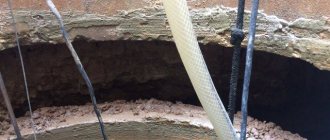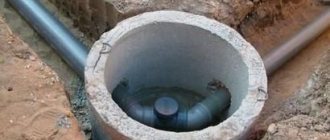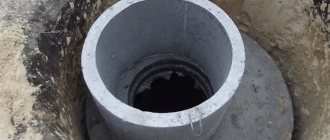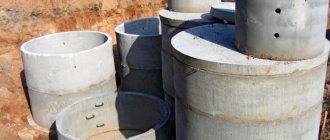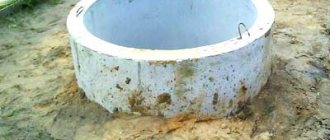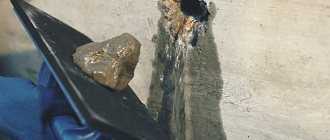Drainage concrete well
Advantages and disadvantages
Pros:
- construction will take no more than one day;
- tightness;
- low cost;
- service life - about thirty years;
- the strength indicator is high;
- does not require constant care.
Important detail : Despite all the advantages, there is one negative point - the heavy weight of the rings. To install them, you will need several assistants and special equipment.
Varieties
There are several types of drainage wells made of concrete rings:
- observation;
- absorption, or it is also called filtering;
- storm water intake, or it is called storage;
- turning.
Lookout
This design is responsible for the condition of the pipeline. Over time, silt forms, along with particles of clay, sand and earth. If solid particles get inside, they can damage the walls of the pipes. To ensure that this does not happen, drainage inspection structures are installed.
Such construction can be rotary/simple. Cleaning occurs using water pressure.
As for the device, the drainage well made of concrete inspection rings is designed very simply. Fittings act as pipe connectors. The body (inside) can be smooth/corrugated.
Sometimes there are viewing structures with a stepped shape. The top of the structure is covered with a lid.
As for the sizes, as a rule, they are small (within 350-450 mm in diameter). Sometimes there are large structures (800-1400 mm in diameter).
Filtering
Filtration well diagram
A concrete filter drainage well is used to clean and drain a personal plot. It does a good job of cleaning wastewater from contaminants. For construction you will need reinforced links (reinforced concrete or simple ones made from concrete mixture are also suitable).
Note : It is usually erected where water cannot be drained into a reservoir or into the ground. As for the shape, the design can have not only a cylindrical shape, but also a cone-shaped/rectangular shape.
Technology:
- They dig a pit two meters deep. The diameter is slightly larger than the diameter of the ring.
- Link immersion. One is installed on the other.
- Crushed stone is placed in the bottom and the space behind the links.
- make holes for pipes. For this purpose, diamond drilling is used (it is worth considering that this process will not be cheap).
- If the top of the structure is above ground level, it is removed.
- The top of the structure is covered with geotextile material.
Rainwater inlet
A rainwater inlet structure is built to allow liquid to accumulate in it, which comes from the storm septic tank. The water intake structure must have a bottom on which a cushion of concrete mixture is placed, or a screed can be made.
The cracks should be sealed with jute fiber if the links do not fit into the lock.
Tip : It is worth noting that the structure must be periodically cleaned using a pump.
The technology is similar to a filter well. The difference is the presence of a pump and the location of the tank (it is installed below the passing pipeline).
They are usually erected if the soil layer consists of loamy/clayey/rocky rocks.
Turning
The essence of this design is that, unlike other types of wells, it is convenient to connect corner and cross-shaped pipes to it.
The construction of a well from concrete rings of this type is not complicated:
- Dig a hole for a couple of links.
- Small holes are made in them through which pipes will be passed.
- Make corner connections.
- The top of the well is covered with a lid.
Purpose and design of the drainage system
Drainage must be carried out if the house is located in a low-lying area, or the groundwater level is higher than the ground floor or basement of the building, and there is a risk of flooding. It is especially important to drain the area located on clay soils, which are prone to heaving when the lower layers freeze during the cold period.
The drainage system simultaneously performs several important functions:
- reduces groundwater pressure on the walls and floor of the house;
- prevents flooding of basements;
- drains the area adjacent to the building.
It is advisable to carry out the arrangement of drainage at the stage of digging a foundation pit for the house, so as not to disturb the landscape of the site when outbuildings have already been erected and equipped on it.
Image galleryPhoto from A drainage well is a functional component of the drainage system, which is designed to collect and drain groundwater. The installation of a drainage system along with the installation of wells should be carried out at the stage of foundation construction. The drainage system is installed before the installation of formwork for pouring the foundation. Wells installed at points where the direction of the drainage pipe changes , i.e. in the corners, serve to monitor the operation of the system. The drainage system is laid separately from the standard and storm sewer systems. It can only be connected to a storm drain in a common collector well. The construction of formwork for pouring a slab or strip type foundation is carried out after laying all types of sewer pipes and installing objects. Work on pouring the foundation and further arrangement of communications is carried out taking into account already installed systems. After insulation of the foundation and introduction into the basement space necessary communications, the pit is backfilled. The drainage well is cut 10 -15 cm above the level of the compacted fill and a hatch is installed. Purpose of drainage wells Time and place of installation Laying geotextiles at the bottom of the trench Installation of drainage wells in the corners Specifics of organizing the drainage system Construction of formwork after laying pipes Pouring the foundation, taking into account communications The final stages of drainage arrangement
To install a drainage system around the perimeter of the house, a trench is being developed. It should be located at a distance of one and a half to three meters from the foundation pit or building (if the house has already been built).
Then a closed pipeline is laid into it, and one or more drainage wells are installed in the necessary places. The number of wells and pipe channels depends on the area of the site, the depth of groundwater, and the type of soil.
The figure shows that in the absence of drainage, groundwater puts pressure directly on the base of the foundation and walls and seeps into the house. If there is a drainage system, the water goes into the outlet pipes
Some people confuse the drainage system with the stormwater system, but the difference between them is quite significant. Storm drainage is designed to drain rainwater and, as a rule, is located on the surface. The depth of the drainage pipes should be below the base of the foundation.
When arranging stormwater and drainage systems, it is possible to divert the pipes of both sewers into one collector well
You can read about how to develop a drainage system project for collecting and draining groundwater, draining and landscaping a site in another popular article on our website.
How to make a drainage well from concrete rings on your own?
DIY installation process
First of all, it is worth noting that the sizes of the rings for different types of structures differ from each other. For example, for the filter structure, reinforced rings are used (ordinary ones made of concrete mixture/reinforced concrete can be used) in the form of a rod (the diameter of which is about twelve millimeters). As a rule, in this case, three rings are enough, which are laid by extension.
Before installing concrete rings, it is necessary to dig a hole under the drainage well itself, 1.5 m deep. It is worth noting that the holes should be located at the lowest point.
Important : To carry out this process you will need either a winch or a crane (do not forget that the rings weigh more than five tons).
If you are building an absorption structure, then in this case it is necessary to create a cushion of crushed stone/gravel, 1.5 m deep.
As for the water intake construction, in this case a bottom/screed is constructed. Then they are laid (one ring is placed on another). In the link that is closest to the surface, a small hole is made for the pipe. Using cement, cover all the cracks around the pipes. You can also use mastic.
As for the “viewing points,” they can be located both at the corners of the connection and on even sections that are slightly inclined.
Materials for drainage wells
Currently, residents of suburban villages, when constructing drainage systems, mainly use two types of wet drainage wells, which are made of concrete or plastic.
Concrete ring for drainage well
A concrete drainage tank is a permanent structure that can be assembled from reinforced concrete rings or poured into prepared formwork. The first option is simpler in terms of construction, the second is cheaper if you do the whole process yourself. But, as practice shows, today many summer residents choose rings.
True, increasingly, ready-made plastic wells have begun to replace concrete ones. They are not only cheaper, but also easier to install and install. For this there is no need to use lifting mechanisms, as is the case with concrete rings. They can be lowered into the prepared pit by hand. In this case, you can select a well with the required number of outlets that will exit the tank in a certain place, which makes it possible to once again simplify the installation process.
Plastic inspection wells
There are other benefits of plastic drainage wells.
- Service life – 50 years. It is guaranteed if the installation is carried out correctly.
- The connection to the pipe is made using a rubber cuff, which ensures tightness. The cuff will serve its purpose throughout the life of the well.
- Typically, plastic drainage tanks are made like a corrugated pipe. The stiffening ribs, in fact, perform the functions of fastening to the ground, which is why the well is held securely in the ground.
How to deepen a drainage well?
The process of deepening concrete rings occurs using the digging method:
- Pump out the liquid.
- A man dives into the mine and begins to dig up the ground.
- Using a bucket, the soil is lifted to the surface.
- The concrete links are gradually lowered. A place will appear at the top to install a new ring.
It is worth noting that such a process will take a lot of time and effort. Digging should be done carefully.
Attention : Recently, concrete drainage structures have faded into the background; polymer ones are now in first place.
Plastic well for drainage
Plastic products
Advantages:
- service life exceeds half a century;
- the corrugated pipe sits securely in the ground thanks to the stiffening ribs;
- pipes can be at any angle;
- due to the light weight of the product it is easy to transport;
- quick and easy installation;
- no crane needed.
However, it will cost several times more than concrete. You can save money if you do the installation yourself.
To work you will need:
- corrugated pipe;
- bottom;
- seals.
Process:
- The pipe is cut off. Then holes are made through which perforated pipes are passed. Place the cuffs.
- They dig a hole. Create a cushion of crushed stone and sand. Fill with cement and lay geotextiles.
- They make the bottom. Then a pipe is connected to it. The junction is sealed with mastic.
- Connect the pipes. The joints are sealed with mastic.
- Install the pump.
- The resulting space is filled with crushed stone.
- They make a lid.
Basic principles of drainage arrangement on the site
To install the drainage system, the highest point of the site is selected, and a trench is dug from it with a slope of 2 to 5 cm, two meters deep, where the pipes are laid. Rotary wells are installed in the corners, and inspection wells are installed in the places of nodal connections.
To ensure the natural flow of water through the pipes, a trench for laying a sewerage system is dug at a slope of at least 2 cm from the top point of the site
The end point of the sewer system, where all pipes laid with a slope lead, is a filter or storage well, from where forced or natural drainage of water is carried out.
For the installation of drainage sewerage, it is recommended to use special corrugated pipes with perforation, made of PVC or polyethylene. They have no technical restrictions on installation and are very easy and simple to install. Depending on the size of the outlet holes in the drainage well, you can purchase pipes with a diameter of 50 to 200 mm.
There are small slits throughout the entire area of the drainage pipe, which are necessary for water to seep out from the soil.
For the full operation of the entire sewer system, it is necessary to carry out a number of preparatory measures. Sand is poured into a 5 cm layer at the bottom of the trench and compacted thoroughly. Then the bottom and walls of the ditch are covered with geofabric, which will serve as a filter to prevent siltation of the system.
This is followed by a layer of crushed stone, approximately 10 cm on which a perforated pipe is placed, covered with another layer of crushed stone and wrapped in geofabric with an overlap. On top of this “pie” is poured a layer of earth, which was selected when digging the trench.
To ensure the full functioning of the drainage system, it is necessary to carefully prepare the base and lay the pipes in the manner shown in the photo


